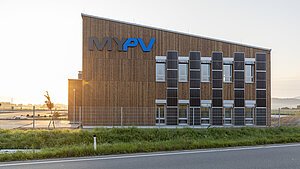In autumn 2022 the INNOTECH team led by Selina Bauchinger and Jürgen Silmbroth was working for Teccon GmbH, based in Spittal an der Drau on Millstatt lake in Austria.The customer had decided to install solar panels on the approximately 1,300 m² roof surface of the company building, and in future to generate at least part of its own power requirements itself.
424 PV modules having a total output of 171.72 kWp were therefore to be installed on the rectangular flat roof, which has an inclination of 2°.From the very start, the safety on the roof of all servicing and cleaning workers was a matter of the utmost importance to the company’s management. They therefore decided in favour of professional and appropriately comprehensive planning for the solar power plant. This included fall protection from INNOTECH.
The project – the plan …
In mid-November last year INNOTECH went to work, and started by creating a comprehensive safety concept for Teccon. After an onsite inspection, and taking all relevant parameters into account, it quickly became clear that for this PV installation, the AIO lifeline system combined with a number of single anchor points was the optimum fall protection solution.
Indeed, in the course of the planning phase it became clear that a solution had to be created for Teccon which could be installed directly on the PV system’s substructure. This would provide all workers on the roof not only with 100% protection while they performed their tasks, but it would also ensure that the safety solution itself created no shading, which in turn would have impaired the efficiency of the solar power plant.
In addition, this allowed the roof surface to be used optimally for PV modules, together with sufficient space for all access routes needed for cleaning and servicing tasks. This was possible only because from the outset Teccon heeded the aspect of safety for the PV system on the roof.
Therefore, even before installing the modules, it was also possible to ensure that the entire system is also fully legally compliant, because the safety concept takes every aspect of the current legal situation into account, and therefore also complies optimally with all the newest standards (as per ÖNORM B3417).
Full documentation even in the planning phase
This project too was fully documented and recorded in the INNOTECH database. In this way every fall protection system is traceable at any time down to the smallest detail, and it can also be maintained and serviced with no great effort. This also applies to all materials, parts, and components used, which in this case too were delivered to the construction site within just a few working days, in order that the installation of the equipment could start quickly.
For Teccon, 2 lifeline systems, each 67 metres in length and having 2 single anchor points, were planned and delivered. For this, see also the blog about the installation of Teccon’s PV system. As early as the planning phase, Jürgen Silmbroth, Training Manager, Applications Engineer at INNOTECH worked very closely with the distributor, BayWa r.e. Solar AT, who recommended a Novotegra substructure for this project.
But very early on (i.e. in the planning phase) there was also close cooperation with the professionals from MET Elektro Unterlerchner GmbH, who were responsible for installing the PV system. Selina Bauchinger from INNOTECH Product Management was kept up to date by BayWa r.e. Solar AT about the details of the PV system. Via the Solar-Planit planning tool, Selina was kept up to date with the details, such as the roof plan and the layout plan of the photovoltaic system and the roof.
In this way it was possible to define the best possible and most economical solution in advance – professionally and with no complications, and as defined by the AUVA planning foundations, equipment class II. BayWa r.e. then made sure to witness the onsite installation, in order to participate in the fall protection system almost in real life.
This forward-looking and coordinated approach, and the selection of the AIO lifeline system, avoided any form of roof penetration when installing the fall protection system during the construction phase, because the system is held down by superimposed load, thanks to direct installation onto the PV substructure. This not only has the benefit that the building’s roof cladding did not have to be breached, but also that the solar system installer did not require any roofers for installing the PV system.
This meant significant cost savings for the customer, because he had no need to engage other craftsmen. In the medium to long term, opening the roof can often create leak points which can over time cause problems. In addition, when there is no roof penetration, the statics properties of the roof are retained in full.
And so for this reason too, timely planning of the fall protection system is always a sound decision. Of course, for this one should always rely on professionals who have comprehensive expertise and the necessary know-how. This is the only way that operators of PV systems are guaranteed to obtain a modern, certified fall protection system which fulfils all requirements.
The optimum solution right from the start
The customer immediately indicated its enthusiasm for the first proposals, and engaged INNOTECH to implement the safety concept.
They had the right solution for our PV installation,
reported the client’s management, who are also very pleased that not only can the solar panels now be cleaned and serviced properly and in absolute safety, but so can all other elements and modules on the roof, such as the air conditioners, smoke extractors, and skylights, as well as the roof itself.


![[Translate to Englisch:] PV substructure including fall protection](https://www.innotech-safety.com/fileadmin/_processed_/e/7/csm_IMG_0044_a2397a2290.jpeg)
![[Translate to Englisch:] Mounting AIO on PV substructure](https://www.innotech-safety.com/fileadmin/_processed_/5/3/csm_IMG_0032_2670fe897c.jpeg)
![[Translate to Englisch:] PV system with fall protection](https://www.innotech-safety.com/fileadmin/_processed_/1/a/csm_IMG_0028_36c49ea922.jpeg)



![[Translate to Englisch:] Flat roof protection with the AIO](https://www.innotech-safety.com/fileadmin/_processed_/4/7/csm_IMG_5568_6e36bbf20f.jpeg)

